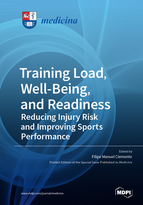Training Load, Well-Being, and Readiness: Reducing Injury Risk and Improving Sports Performance
A special issue of Medicina (ISSN 1648-9144). This special issue belongs to the section "Sports Medicine and Sports Traumatology".
Deadline for manuscript submissions: closed (30 September 2021) | Viewed by 21875
Special Issue Editor
Interests: football; soccer; match analysis; performance analysis; network analysis
Special Issues, Collections and Topics in MDPI journals
Special Issue Information
Dear Colleagues,
Monitoring the athlete’s performance is part of a sports training puzzle that aims to decrease injury risk and improving the ultimate performance. Therefore, applying a consistent monitoring system involves individually track the internal and external load of athletes, analyze the impact of accumulated load and peripherical factors on well-being and assess the athlete’s readiness. These main topics allow coaches and sports scientists to make decisions about the more adequate training approaches to implement in the athletes.An individual training process depends on well-implemented monitoring systems that provide important information about the thresholds of increasing or decreasing the load, managing the athlete, and reduce the injury risk associated with erroneous training plans. Despite too much information provided by monitoring systems, it still needs more and better research that helps to bring more accurate and precise information that helps to understand critical points or identify the most appropriate approaches based on the interaction between factors.Therefore, this special issue “Training load, well-being, and readiness: reducing injury risk and improving sports performance” aims to bridge the gap between theory and practice, providing an opportunity to publish original articles, systematic reviews, and/or meta-analyses conducted in the topics of (i) training load monitoring and interactions with fitness, injury risk, and sports performance; (ii) well-being monitoring and interactions with training load, lifestyle, nutrition, and psychological factors; and (iii) readiness assessment and interactions with fatigue, training load, and well-being.
Dr. Filipe Manuel Clemente
Guest Editor
Manuscript Submission Information
Manuscripts should be submitted online at www.mdpi.com by registering and logging in to this website. Once you are registered, click here to go to the submission form. Manuscripts can be submitted until the deadline. All submissions that pass pre-check are peer-reviewed. Accepted papers will be published continuously in the journal (as soon as accepted) and will be listed together on the special issue website. Research articles, review articles as well as short communications are invited. For planned papers, a title and short abstract (about 100 words) can be sent to the Editorial Office for announcement on this website.
Submitted manuscripts should not have been published previously, nor be under consideration for publication elsewhere (except conference proceedings papers). All manuscripts are thoroughly refereed through a single-blind peer-review process. A guide for authors and other relevant information for submission of manuscripts is available on the Instructions for Authors page. Medicina is an international peer-reviewed open access monthly journal published by MDPI.
Please visit the Instructions for Authors page before submitting a manuscript. The Article Processing Charge (APC) for publication in this open access journal is 1800 CHF (Swiss Francs). Submitted papers should be well formatted and use good English. Authors may use MDPI's English editing service prior to publication or during author revisions.
Keywords
- training load
- injury prevention
- injury risk
- illness
- well-being
- wellness
- sports performance
- readiness
- sports training







